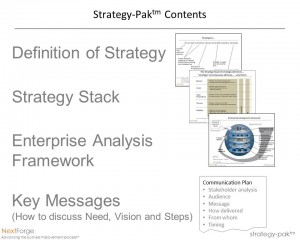 About 15 years ago we were working together at a rapidly expanding management consulting firm. One of our issues was aligning a diverse group of seasoned consultants around a definition of strategy and its component parts. You know the drill… “Does the mission statement inform the vision, or is it the other way around?” We spent several weeks at night and on weekends to develop a consistent base-line, a package of strategic elements which collectively would allow our clients to test their bits and pieces of strategy- and weave them into a coherent whole. And, it allowed our colleagues to focus more on business outcomes and less on taxonomy.
About 15 years ago we were working together at a rapidly expanding management consulting firm. One of our issues was aligning a diverse group of seasoned consultants around a definition of strategy and its component parts. You know the drill… “Does the mission statement inform the vision, or is it the other way around?” We spent several weeks at night and on weekends to develop a consistent base-line, a package of strategic elements which collectively would allow our clients to test their bits and pieces of strategy- and weave them into a coherent whole. And, it allowed our colleagues to focus more on business outcomes and less on taxonomy.
Recently, we had the opportunity to take a blank page approach to strategy with a client. Let’s call them ABCommodity who, while in their 3rd-4th generation of leadership, had for more than 50 years focused primarily on operational excellence. The great recession not only revealed a gap in the operational excellence approach, it required ABC to stop losing money or lose control to active investors.
It never ceases to surprise us, just how often and how important it is to reach back to what we think of as foundational business concepts. So, once again, we pulled out our strategy basics, now burnished and pressure-tested with years of consultative use and learnings to fill a critical leadership capability plank at ABC. The following are ABC’s key c-suite learnings from re-building their competitive strategy from the ground up.
 Strategy is a package of elements including
Strategy is a package of elements including
– Definition of strategy
– Strategy stack: a hierarchical stack of mission, vision, value propositions, themes, roadmap of initiatives
– Key performance indicators (measures and targets)
– Enterprise analysis framework
– Communications- Change leadership is at least as important as content, and potentially more important
– Change happens by changing behavior: one person at a time - Strategic execution requires a project discipline by both staff and executives
- Communications is critical to participation and adoption, and requires more than a one-way effort
– The social impact of two-way communications built unexpected momentum for cultural alignment and cultural change
– The organization has just scratched the surface of unlocking the energy, knowledge and ideas of the individuals
This is our introductory post in a definitional series on the key elements of strategy. We will also include a few observations along the way on how we have, or might, advance the more traditional concepts. Collectively, we refer to the grouping of strategic concepts as the strategy-paksm.








2 Responses
Also see our post “What to do with the strategy-pak: A starter list” https://nextforge.com/?p=1738 … to see some tried and true uses for this strategic frame.
Enjoy
Tom Reeder